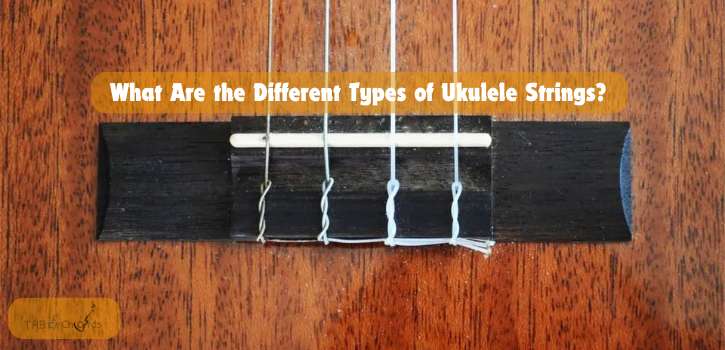What Are the Different Types of Ukulele Strings?
When choosing ukulele strings, you’re not just picking a random set of strings; you’re selecting a vital part of your instrument’s tone, playability, and feel. Different types of strings can dramatically change your ukulele’s sound and the way it responds to your playing. Let’s explore the various types of ukulele strings, their characteristics, and how they might suit different playing styles and preferences.
1. Nylon Strings
Characteristics:
Nylon strings are one of the most common types used for ukuleles. They offer a warm, mellow sound that’s smooth and easy on the fingers. Nylon is a relatively flexible material, making these strings easier to press down, which is great for beginners.
Advantages:
- Soft and comfortable to play
- Affordable and widely available
- Provides a traditional, warm sound
Disadvantages:
- Can stretch over time, requiring frequent retuning
- Less bright compared to other materials
Ideal for:
- Beginners and those looking for a traditional ukulele sound
- Genres like folk, pop, and Hawaiian music
2. Fluorocarbon Strings
Characteristics:
Fluorocarbon strings are made from a type of plastic similar to fishing line. These strings are slightly harder and denser than nylon, resulting in a brighter and crisper tone. They are also more resistant to temperature and humidity changes, making them more stable in tuning.
Advantages:
- Bright and clear sound
- Stable tuning with less stretching
- Durable and long-lasting
Disadvantages:
- Slightly more expensive than nylon strings
- Can feel stiffer under the fingers
Ideal for:
- Intermediate to advanced players seeking a brighter tone
- Genres like jazz, classical, and contemporary music
3. Nylgut Strings
Characteristics:
Nylgut strings, developed by Aquila, aim to replicate the sound and feel of traditional gut strings while using modern synthetic materials. They offer a unique, full-bodied sound that stands out from nylon and fluorocarbon strings.
Advantages:
- Offers a traditional gut-like sound with modern durability
- Rich, warm tone with good projection
- Resistant to wear and tear
Disadvantages:
- Can be more expensive than other types
- May require a break-in period to settle in tuning
Ideal for:
- Players looking for a vintage or traditional sound
- Folk and traditional music styles
4. Wound Strings
Characteristics:
Wound strings combine a nylon or fluorocarbon core with a winding of metal (usually silver, copper, or phosphor bronze). They are typically used for the lower strings (G and C) to add more depth and sustain.
Advantages:
- Provides a richer, fuller sound on lower notes
- More sustain and volume
Disadvantages:
- Can produce string noise when fingers slide over them
- May feel different compared to unwound strings, requiring an adjustment period
Ideal for:
- Players seeking a more dynamic range and richer bass tones
- Ukuleles with a low G tuning
5. Titanium Strings
Characteristics:
Titanium strings are not made of metal titanium but rather a blend of monofilament synthetic material. They offer a bright, clear sound with a bit more punch than traditional nylon strings.
Advantages:
- Bright and resonant sound
- Durable and resistant to environmental changes
- Less stretching, stable tuning
Disadvantages:
- Can be slightly more expensive
- Brightness may not suit all playing styles
Ideal for:
- Players looking for a clear, bright tone with good projection
- Modern and contemporary music styles
6. Gut Strings
Characteristics:
Gut strings are made from the intestines of animals (traditionally sheep). They were the original strings used on early ukuleles and other stringed instruments. Today, they are less common due to ethical and practical reasons but still available for those seeking an authentic, historical sound.
Advantages:
- Warm, rich, and authentic tone
- Traditional and vintage feel
Disadvantages:
- Expensive and less durable
- Sensitive to humidity and temperature changes
- Ethical concerns for some players
Ideal for:
- Historical and traditional music enthusiasts
- Those looking for a specific vintage sound
Choosing the Right Strings
Choosing the right strings for your ukulele depends on several factors, including your playing style, the type of music you play, and your personal preferences for tone and feel. It’s also worth considering the size of your ukulele (soprano, concert, tenor, or baritone), as certain string types may suit different sizes better.
Tips for Choosing Strings:
- Experiment: Don’t be afraid to try different types and brands of strings. Changing strings is an easy way to experiment with different sounds.
- Consider Your Instrument: Some ukuleles may sound better with certain strings due to their construction and wood type.
- Playing Style: If you strum a lot, you might prefer softer, mellower strings like nylon. For fingerpicking, you might enjoy the clarity of fluorocarbon or titanium strings.
Are You Playing the Right Ukulele? Discover the Secrets of Each Type!
Conclusion
The type of strings you choose for your ukulele can significantly influence your playing experience and the sound of your instrument. Whether you’re a beginner or a seasoned player, exploring different strings can help you find the perfect match for your musical style and preferences. Remember, the journey of finding the right strings is part of the joy of playing and discovering your unique sound. Happy strumming!


